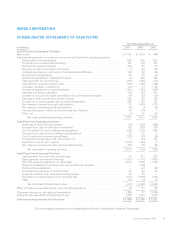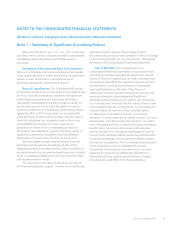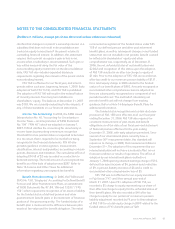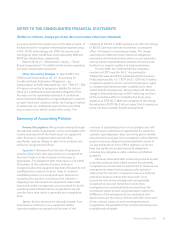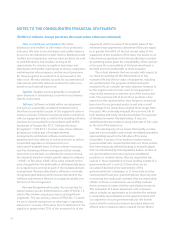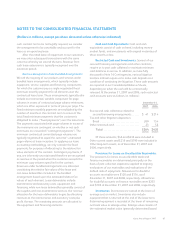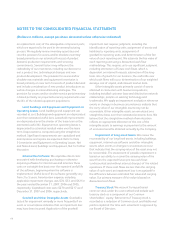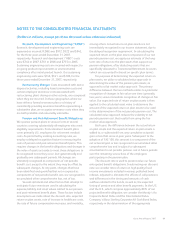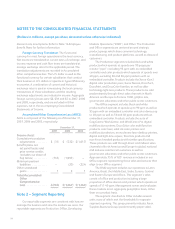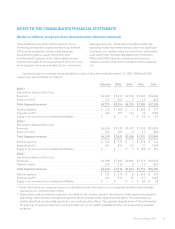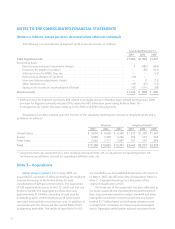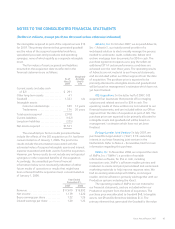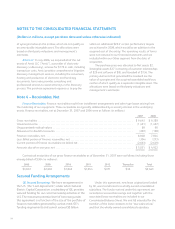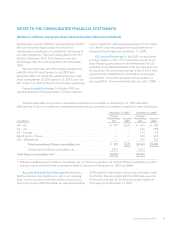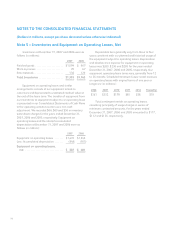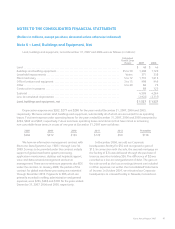Xerox 2007 Annual Report Download - page 90
Download and view the complete annual report
Please find page 90 of the 2007 Xerox annual report below. You can navigate through the pages in the report by either clicking on the pages listed below, or by using the keyword search tool below to find specific information within the annual report.NOTES TO THE CONSOLIDATED FINANCIAL STATEMENTS
(Dollars in millions, except per-share data and unless otherwise indicated)
on replacement cost) of the salvageable component parts,
which are expected to be used in the remanufacturing
process. We regularly review inventory quantities and
record a provision for excess and/or obsolete inventory
based primarily on our estimated forecast of product
demand, production requirements and servicing
commitments. Several factors may influence the
realizability of our inventories, including our decision to
exit a product line, technological changes and new
product development. The provision for excess and/or
obsolete raw materials and equipment inventories is
based primarily on near term forecasts of product demand
and include consideration of new product introductions as
well as changes in remanufacturing strategies. The
provision for excess and/or obsolete service parts inventory
is based primarily on projected servicing requirements over
the life of the related equipment populations.
Land, Buildings and Equipment and Equipment on
Operating Leases: Land, buildings and equipment are
recorded at cost. Buildings and equipment are depreciated
over their estimated useful lives. Leasehold improvements
are depreciated over the shorter of the lease term or the
estimated useful life. Equipment on operating leases is
depreciated to estimated residual value over the lease
term. Depreciation is computed using the straight-line
method. Significant improvements are capitalized and
maintenance and repairs are expensed. Refer to Note
5-Inventories and Equipment on Operating Leases, Net
and Note 6-Land, Buildings and Equipment, Net for further
discussion.
Internal Use Software: We capitalize direct costs
associated with developing, purchasing or otherwise
acquiring software for internal use and amortize these
costs on a straight-line basis over the expected useful life
of the software, beginning when the software is
implemented. Useful lives of the software generally vary
from 3 to 5 years. Amortization expense, including
applicable impairment charges, was $76, $73, and $92 for
the years ended December 31, 2007, 2006 and 2005,
respectively. Capitalized costs were $270 and $217 as of
December 31, 2007 and 2006, respectively.
Goodwill and Other Intangible Assets: Goodwill is
tested for impairment annually or more frequently if an
event or circumstance indicates that an impairment loss
may have been incurred. Application of the goodwill
impairment test requires judgment, including the
identification of reporting units, assignment of assets and
liabilities to reporting units, assignment of
goodwill to reporting units, and determination of the fair
value of each reporting unit. We estimate the fair value of
each reporting unit using a discounted cash flow
methodology. This requires us to use significant judgment
including estimation of future cash flows, which is
dependent on internal forecasts, estimation of the long-
term rate of growth for our business, the useful life over
which cash flows will occur, determination of our weighted
average cost of capital, and relevant market data.
Other intangible assets primarily consist of assets
obtained in connection with business acquisitions,
including installed customer base and distribution network
relationships, patents on existing technology and
trademarks. We apply an impairment evaluation whenever
events or changes in business circumstances indicate that
the carry value of our intangible assets may not be
recoverable. Other intangible assets are amortized on a
straight-line basis over their estimated economic lives. We
believe that the straight-line method of amortization
reflects an appropriate allocation of the cost of the
intangible assets to earnings in proportion to the amount
of economic benefits obtained annually by the Company.
Impairment of Long-Lived Assets: We review the
recoverability of our long-lived assets, including buildings,
equipment, internal-use software and other intangible
assets, when events or changes in circumstances occur
that indicate that the carrying value of the asset may not
be recoverable. The assessment of possible impairment is
based on our ability to recover the carrying value of the
asset from the expected future pre-tax cash flows
(undiscounted and without interest charges) of the related
operations. If these cash flows are less than the carrying
value of such asset, an impairment loss is recognized for
the difference between estimated fair value and carrying
value. Our primary measure of fair value is based on
discounted cash flows.
Treasury Stock: We account for repurchased
common stock under the cost method and include such
treasury stock as a component of our Common
shareholders’ equity. Retirement of Treasury stock is
recorded as a reduction of Common stock and Additional
paid-in-capital at the time such retirement is approved by
our Board of Directors.
88



